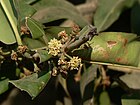Note: This is a project under development. The articles on this wiki are just being initiated and broadly incomplete. You can Help creating new pages.
Difference between revisions of "Manilkara hexandra - Kshirini"
(→Common names) |
(→References) |
||
| (One intermediate revision by the same user not shown) | |||
| Line 35: | Line 35: | ||
==Identification== | ==Identification== | ||
===Leaf=== | ===Leaf=== | ||
| − | {{Leaf|Simple| | + | {{Leaf|Simple|Alternate|Estipulate; petiole 8-20 mm, slender, slightly grooved above, glabrous}}<ref name="Leaf"/> |
===Flower=== | ===Flower=== | ||
| − | {{Flower|Bisexual| | + | {{Flower|Bisexual|Axillary|Pale yellow|10|7 mm across, white, 1 or 2 axillary; pedicel to 3.5 cm long; calyx lobes 6, in 2 series of 3 each, 2.5 x 2 mm, reflexed, ovate, subacute, rusty-tomentose outside; corolla 3 x 1.5 mm, lobes 18 in 3 series of 6 each, valvate; stamen 6-8}} |
===Fruit=== | ===Fruit=== | ||
| − | {{Fruit|A berry|1.5 x 8 mm||Ellipsoid, reddish-yellow| | + | {{Fruit|A berry|1.5 x 8 mm||Ellipsoid, reddish-yellow|Seed usually one}} |
===Other features=== | ===Other features=== | ||
| Line 76: | Line 76: | ||
<ref name="How to plant/cultivate">[http://artimedicinalplants.blogspot.com/2018/01/manilkara-hexandra.html#:~:text=Cultivation%20Collection%2D&text=Suitable%20temperature%20range%20of%20khirni,with%20a%20sandy%2Cloamy%20texture. Cultivation]</ref> | <ref name="How to plant/cultivate">[http://artimedicinalplants.blogspot.com/2018/01/manilkara-hexandra.html#:~:text=Cultivation%20Collection%2D&text=Suitable%20temperature%20range%20of%20khirni,with%20a%20sandy%2Cloamy%20texture. Cultivation]</ref> | ||
<ref name="chemical composition">[https://www.easyayurveda.com/2019/09/03/khirni-manilkara-hexandra/ Chemical constituents]</ref> | <ref name="chemical composition">[https://www.easyayurveda.com/2019/09/03/khirni-manilkara-hexandra/ Chemical constituents]</ref> | ||
| − | <ref name="Leaf">[http://FLOWERING PLANTS OF KERALA VER.2, N. Sasidharan | + | <ref name="Leaf">[http://FLOWERING PLANTS OF KERALA VER.2, N. Sasidharan Botanic description]</ref> |
| − | <ref name="Common names">[http://envis.frlht.org/bot_search | + | <ref name="Common names">[http://envis.frlht.org/bot_search Vernacular names]</ref> |
Latest revision as of 17:22, 25 November 2020
Kshirini is a small tree with glossy leaves and very fragrant flowers closely realted to the Sapota (Manilkara zapota) The stems and leaves exude a milky sap when bruised.
Contents
- 1 Uses
- 2 Parts Used
- 3 Chemical Composition
- 4 Common names
- 5 Properties
- 6 Habit
- 7 Identification
- 8 List of Ayurvedic medicine in which the herb is used
- 9 Where to get the saplings
- 10 Mode of Propagation
- 11 How to plant/cultivate
- 12 Commonly seen growing in areas
- 13 Photo Gallery
- 14 References
- 15 External Links
Uses
Excess thirst, Emaciation, Bleeding disorders, Ulcer, Bronchitis, Fever, Jaundice.
Parts Used
Chemical Composition
Manilkara hexandra contains phytoconstituents such as sterols, tennin, saponin, unsaponifiable lipids, triterphin alcohol, terpenoids and phenolic compounds such as gallic acid, myrectin and querectin. [1]
Common names
| Language | Common name |
|---|---|
| Kannada | Hale hannu, Khiranee, Kiraale, Ksheera vriksha |
| Hindi | Khir, Khirni, Kshiri, Ranjan |
| Malayalam | Khrini, Manilakkara, Palamunnippalaelengi, Pala |
| Tamil | Kannupalalai, Kanupala, Karupala, Kirni, Palai, Ulakkaipalai |
| Telugu | Kirni, Manchipala, Manjipaala, Pala chettu |
| Marathi | NA |
| Gujarathi | NA |
| Punjabi | NA |
| Kashmiri | NA |
| Sanskrit | Rajadana, Drdhaskandha, Kshirashukla, Kshiravriksha, Kshiri, Kshirika, Kshirini, Ksiri, Madhuphala |
| English |
.[2]
Properties
Reference: Dravya - Substance, Rasa - Taste, Guna - Qualities, Veerya - Potency, Vipaka - Post-digesion effect, Karma - Pharmacological activity, Prabhava - Therepeutics.
Dravya
Rasa
Guna
Veerya
Vipaka
Karma
Prabhava
Habit
Identification
Leaf
| Kind | Shape | Feature |
|---|---|---|
| Simple | Alternate | Estipulate; petiole 8-20 mm, slender, slightly grooved above, glabrous |
Flower
| Type | Size | Color and composition | Stamen | More information |
|---|---|---|---|---|
| Bisexual | Axillary | Pale yellow | 10 | 7 mm across, white, 1 or 2 axillary; pedicel to 3.5 cm long; calyx lobes 6, in 2 series of 3 each, 2.5 x 2 mm, reflexed, ovate, subacute, rusty-tomentose outside; corolla 3 x 1.5 mm, lobes 18 in 3 series of 6 each, valvate; stamen 6-8 |
Fruit
| Type | Size | Mass | Appearance | Seeds | More information |
|---|---|---|---|---|---|
| A berry | 1.5 x 8 mm | Ellipsoid, reddish-yellow | Seed usually one | {{{6}}} |
Other features
List of Ayurvedic medicine in which the herb is used
Where to get the saplings
Mode of Propagation
How to plant/cultivate
Suitable temperature range of khirni tree is 10-38⁰c and most fruit tree prefers a soil which has pH between ranges 6.0-7.0. Fruit trees grow best in well drained soil with a sandy,loamy texture. [4]
Commonly seen growing in areas
Photo Gallery
References
External Links
- Ayurvedic Herbs known to be helpful to treat Excess thirst
- Ayurvedic Herbs known to be helpful to treat Emaciation
- Ayurvedic Herbs known to be helpful to treat Bleeding disorders
- Ayurvedic Herbs known to be helpful to treat Ulcer
- Ayurvedic Herbs known to be helpful to treat Bronchitis
- Ayurvedic Herbs known to be helpful to treat Fever
- Ayurvedic Herbs known to be helpful to treat Jaundice
- Herbs with Fruits used in medicine
- Herbs with Root used in medicine
- Herbs with Leaves used in medicine
- Herbs with common name in Kannada
- Herbs with common name in Hindi
- Herbs with common name in Malayalam
- Herbs with common name in Tamil
- Herbs with common name in Telugu
- Herbs with common name in Sanskrit
- Habit - Tree
- Index of Plants which can be propagated by Seeds
- Herbs that are commonly seen in the region of Tropical area
- Herbs
- Tree
- Ayurvedic herbs that don't have seed photos
- Sapotaceae





